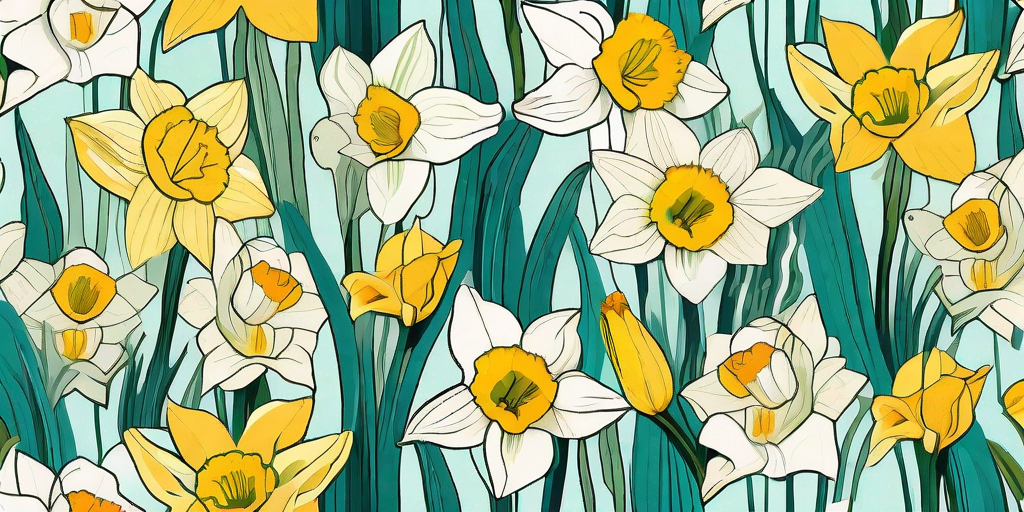
Ah, the daffodil. A flower that's as cheerful as a sunny day and as vibrant as a child's laughter. This delightful bloom is a harbinger of spring, bringing joy to gardens and landscapes with its radiant hues and charming disposition. But did you know that there's more to the daffodil than meets the eye? In fact, there are numerous varieties of this delightful flower, each with its own unique characteristics and charm. So, let's dive in and explore the world of daffodils, shall we?
The Many Faces of Daffodils
When you think of a daffodil, you probably picture a bright yellow flower with a trumpet-shaped center. But daffodils come in a variety of shapes, sizes, and colors. Some are small and delicate, while others are large and robust. Some have single flowers, while others have multiple blooms on a single stem. And while many daffodils are indeed yellow, they can also be white, orange, pink, or even a combination of these colors.
There are over 13,000 different varieties of daffodils, divided into 13 different divisions based on their characteristics. These divisions include Trumpet Daffodils, Large-cupped Daffodils, Small-cupped Daffodils, Double Daffodils, and more. Each division has its own unique charm and appeal, making the world of daffodils a diverse and fascinating one to explore.
Trumpet Daffodils
Trumpet Daffodils are perhaps the most iconic variety of daffodil. They feature a single flower on each stem, with a trumpet that's as long or longer than the petals. These daffodils are often yellow, but they can also be white or a combination of the two colors.
Some popular varieties of Trumpet Daffodils include 'Dutch Master', 'Mount Hood', and 'Golden Harvest'. These varieties are known for their large, vibrant flowers and their robust growth habit.
Large-cupped Daffodils
Large-cupped Daffodils are similar to Trumpet Daffodils, but their cup (or corona) is shorter than their petals. They also feature a single flower on each stem and come in a variety of colors, including yellow, white, pink, and orange.
Some popular varieties of Large-cupped Daffodils include 'Carlton', 'Ice Follies', and 'Fortissimo'. These varieties are known for their large, colorful flowers and their strong, sturdy stems.
How to Grow Daffodils
Now that you know a bit more about the different varieties of daffodils, you might be wondering how to grow these delightful flowers in your own garden. Well, you're in luck! Daffodils are easy to grow and require minimal care, making them a great choice for both novice and experienced gardeners.
Daffodils are grown from bulbs, which should be planted in the fall. They prefer well-drained soil and full sun to partial shade. Once planted, daffodils require little care. They're resistant to most pests and diseases and can tolerate a range of soil conditions. In fact, once established, daffodils will continue to bloom year after year, bringing joy and color to your garden each spring.
Planting Daffodil Bulbs
When planting daffodil bulbs, it's important to plant them at the right depth. The general rule of thumb is to plant the bulb three times as deep as the bulb is tall. So, if your bulb is 2 inches tall, you should plant it 6 inches deep.
It's also important to plant the bulb with the pointy end facing up. This is where the stem will emerge from, so it needs to be facing the right direction. If you're not sure which end is the top, look for the root plate (the flat, circular area where the roots grow from) - this should be facing down.
Caring for Daffodils
Once your daffodils are planted, they require very little care. They don't need to be watered regularly, as they prefer dry conditions. However, if you live in a particularly dry area, you may want to water them occasionally during the growing season.
After your daffodils have finished blooming, you should leave the foliage in place until it turns yellow and dies back. This allows the plant to store energy for the next year's bloom. Once the foliage has died back, you can remove it to keep your garden looking tidy.
FAQs
When is the best time to plant daffodils?
The best time to plant daffodils is in the fall, about 2 to 4 weeks before the ground freezes. This gives the bulbs a chance to establish roots before the winter sets in.
Can daffodils grow in shade?
While daffodils prefer full sun to partial shade, they can tolerate some shade. However, they may not bloom as well or as consistently in heavily shaded areas.
Do daffodils come back every year?
Yes, daffodils are perennials, which means they come back year after year. In fact, they can live for many years and often multiply, creating a larger display of flowers each spring.
Conclusion
From their vibrant colors to their easy care, there's a lot to love about daffodils. Whether you're a seasoned gardener or a green thumb in training, these cheerful flowers are sure to bring a smile to your face and a touch of spring to your garden. So why not take a leap and plant some daffodils this fall? You'll be rewarded with a delightful display of blooms come spring.
And remember, while the world of daffodils may seem vast and varied, it's also full of joy and delight. So don't be afraid to explore, experiment, and have fun. After all, that's what gardening is all about!















